Some links on this page may contain affiliate links which means that, if you choose to make a purchase using the link, Agricfy.com may earn a small commission at no extra cost to you. For more information, go to our Affiliate Disclosure Page!
Introduction
Catfish farming is one of the most lucrative businesses anyone can start and make money.
If you decide to start a fish farm anytime, one of the major pieces of equipment you will need to raise your fish is a pond.
Most times, the types of ponds to raise fish have been a major cause of confusion for many fish farmers around the world.
In this article, I will be discussing the different types of ponds for fish farming with the advantages and disadvantages of each type of fish pond.
Choosing your preferred type of fish pond depends on some factors which might include but are not limited to: the money you have, the quantity of fish you wish to raise, location of your farm among others.
What Is A Fish Pond?
A fish pond is a place where fish are kept and raised for personal consumption or commercial purposes.
According to Wikipedia, “A fish pond, or fishpond, is a controlled pond, artificial lake, or reservoir that is stocked with fish and is used in aquaculture for fish farming or is used for recreational fishing or ornamental purposes.
In the medieval European era, it was typical for monasteries and castles to have a fish pond”.
In the modern world, people have done research and have come up with different types of ponds that can be used to raise fish.
Some of these types of ponds come with convenience as you can use them for fishing at home and sometimes can be easily moved anywhere.
Types Of Ponds For Fish Farming
1. Earthen Pond
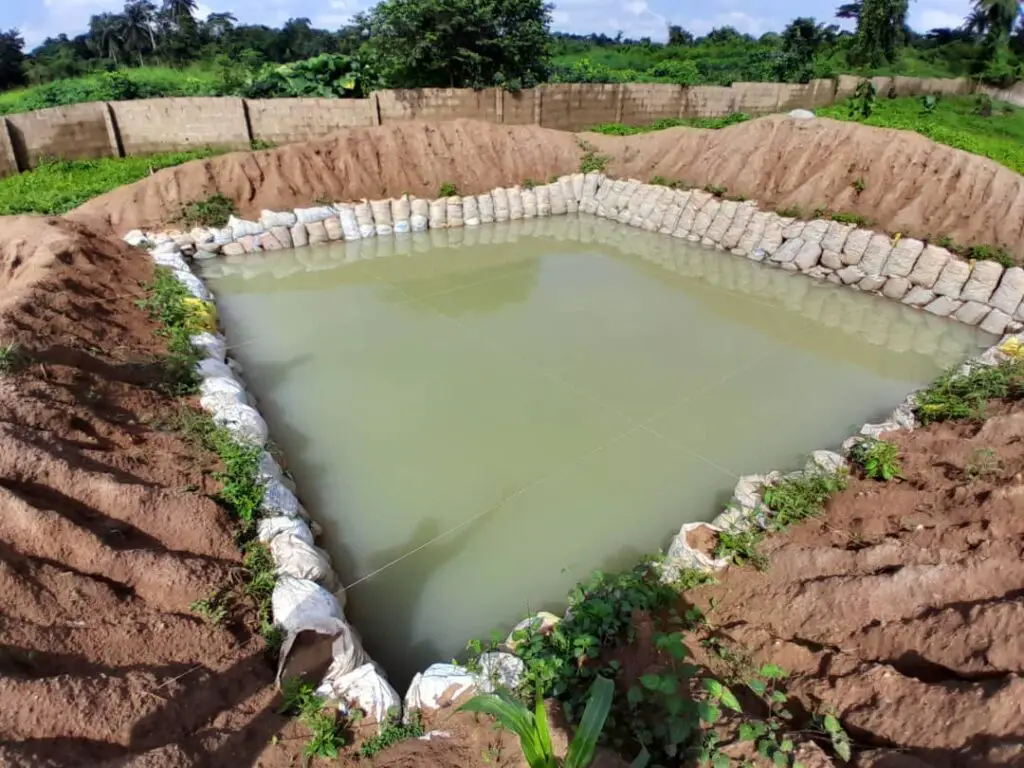
First on the list of the types of ponds that are commonly used for raising catfish is the earthen pond.
An earthen pond is a near-natural habitat for fishes (catfish, tilapia, etc) like a river or stream. Although it is constructed to suit the design of the fish farmer, it is mostly constructed in sloppy or waterlogged areas to accommodate the fish and give them a natural feel when they are being raised.
An earthen pond is an artificial dam, a reservoir constructed by digging a hole that should be at least 1.5 meters deep.
The process of constructing an earthen pond should be carried out by professionals who have been in the business of pond construction for a long time.
Factors To Consider Before Constructing An Earthen Pond
Before choosing to construct an earthen pond, there are 2 crucial factors you need to consider:
i. Location of the land: The first thing to consider before deciding to dig an earthen pond is the location and choice of the land that will be used.
One major key factor in choosing land is that it must be in a place where there is natural water.
ii. Soil Type: The second factor to consider before building an earthen pond is the type of soil that will be used for construction. The best type of soil for the earthen pond is one that can hold water very well.
This can be clay soil or sandy clay soil.
Other factors to consider before constructing an earthen pond are soil permeability and soil texture.
Advantages Of Earthen Pond
- It is the most near-natural type of pond good for raising fish.
- Fish tend to eat natural food like worms compared to other types of ponds.
- Fish grow faster in an earthen pond.
- It has a low maintenance cost
- It is easy to manage the water system in an earthen pond.
Disadvantages Of Earthen Pond
- It is very risky to control if there is a flood
- It requires more space to build an earthen pond
- It is difficult to know when there is an outbreak of diseases and more difficult to control.
- It is difficult to sort in an earthen pond which makes it easy for fish to eat each other (cannibalism)
One important thing about an earthen pond is you don’t need to own your land or construct it yourself to start fishing, you can rent a space and put your fish.
2. Concrete Pond
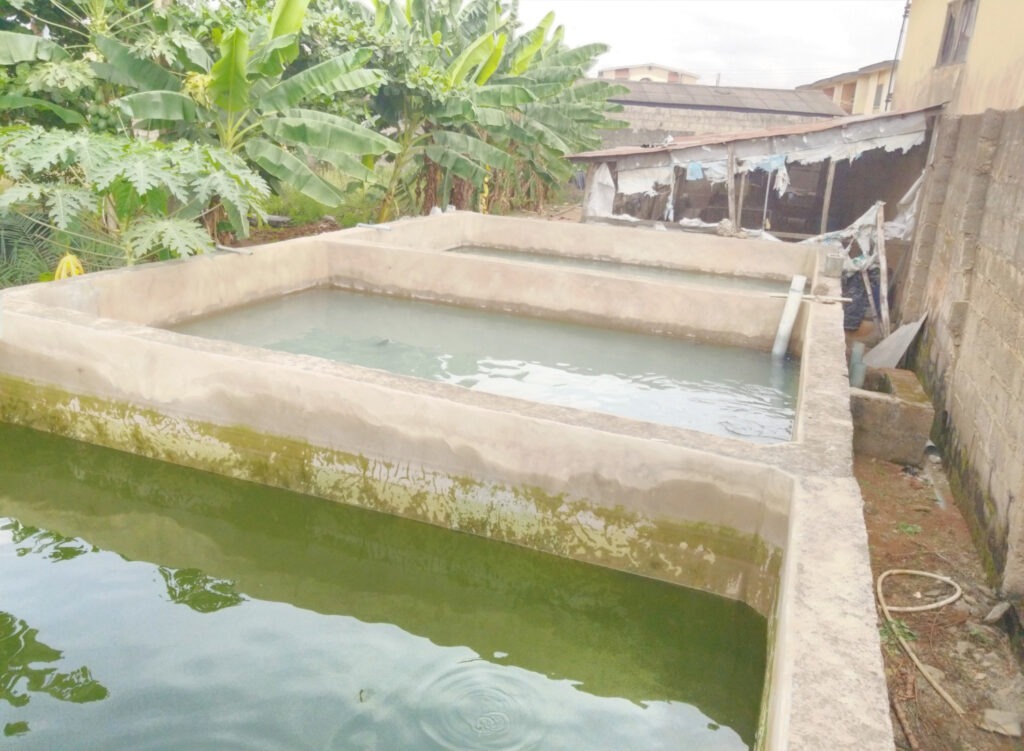
The second type of pond that can be used to raise fish is a concrete pond. This is very common for fish farmers to raise their fish, especially catfish.
A Concrete pond uses blocks, sand, and cement to build a habitat for you to raise your fish.
Constructing concrete ponds requires the help of experts compared to other types of ponds. This is so because any mistake in the construction of the pond can lead to leakages and it might cost more to repair than to construct another one.
One advantage of the concrete pond over the earthen pond is that it can be constructed anywhere even in your house.
Factors to Consider Before Constructing A Concrete Pond
- Location: This is not all a determinant of building a pond. You can build a concrete pond anywhere even in your backyard.
- Drainage System: This is the second factor that is critical to constructing your concrete pond. A good drainage system where you will be disposing of the wastewater should be part of the planning process when you want to build a pond.
- Cost: Setting up a concrete pond is the most expensive among all other types of ponds. You need to look at your pocket before choosing to construct a concrete pond.
Advantages Of Concrete Pond
- It can be constructed on any land
- A concrete pond is better to manage for younger fish like fingerlings and juvenile
- It is easy to notice fish diseases and also control the diseases.
- A concrete pond cannot be affected by flood unlike an earthen pond
- The water system can easily be managed
- It lasts longer than other types of ponds if managed well
Disadvantages of Concrete Pond
- It is expensive to construct
- For you to successfully run a catfish farm, it requires a large amount of water to run a concrete pond
- If you don’t know where to dispose of the water, water waste can become a nuisance in the environment.
- The maintenance cost is very expensive
I have constructed different concrete ponds for clients across the country, you can check my YouTube channel for these videos. So, if you want to construct your pond, reach out by sending me an email or WhatsApp message.
3. Tarpaulin Pond
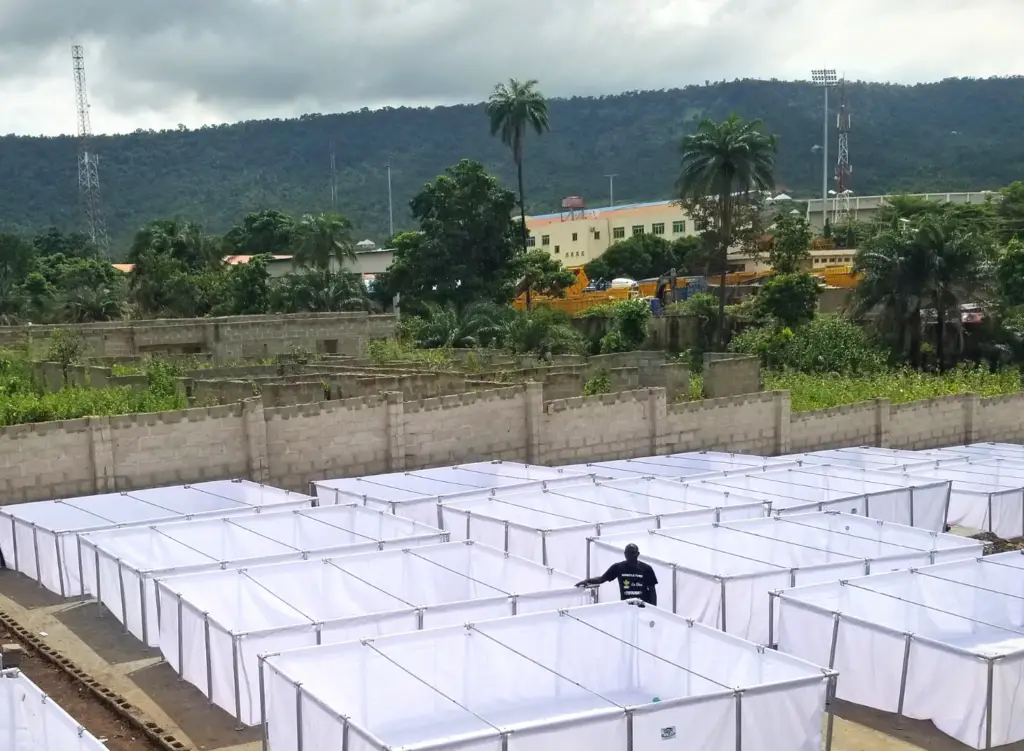
Next on the types of ponds for fish farming is the tarpaulin pond. It is also called a Mobile or moveable pond.
This type of fish pond is the next most common after earthen, concrete, and plastic ponds.
It can be constructed with either wood or galvanized pipes and then covered with a tarpaulin. Tarpaulin pond comes in different sizes and colors.
One of the advantages of the tarpaulin pond over the other types of ponds is that is easy to set up.
Factors To Consider Before Setting Up A Tarpaulin Pond
- Space – Although you don’t need so much space to put up a tarpaulin pond, regardless, you need to make sure that wherever your pond will be, it is free from obstacles that could tear the tarpaulin
- Cost – If you want to fish on a large scale, it is advisable not to use a tarpaulin pond because, in the long run, you will spend more on setting it up compared to if you use a concrete pond or an earthen pond.
- Quality – Another factor to consider before deciding to buy a tarpaulin is quality. If you are going to be buying equipment that will cost you money, you need to be very particular about the quality.
You don’t want a situation where you buy the tarpaulin today, stock it with fish, and in less than a month it has started tearing up. Consult with professionals who know about the best tarpaulin to use and get it from them so you don’t lose money.
Advantages Of Tarpaulin Pond
- It is cost-effective compared to a concrete pond
- It is easy to set up
- Tarpaulin ponds are easily moveable
- Tarpaulin ponds do not require a lot of space.
Disadvantages Of Tarpaulin Pond
- It can easily tear
- Because of its flexibility, heavy wind, rain/flood can quickly destroy the pond
- Tarpaulin ponds can be disassembled and stolen easily
I have had the opportunity to put together tarpaulin ponds in Nigeria, Togo, and Sierra Leone so if you are #teamtarapulin and you’re wondering how to go about it, reach out to me and I will help you set up your pond.
4. Plastic Or Rubber Pond
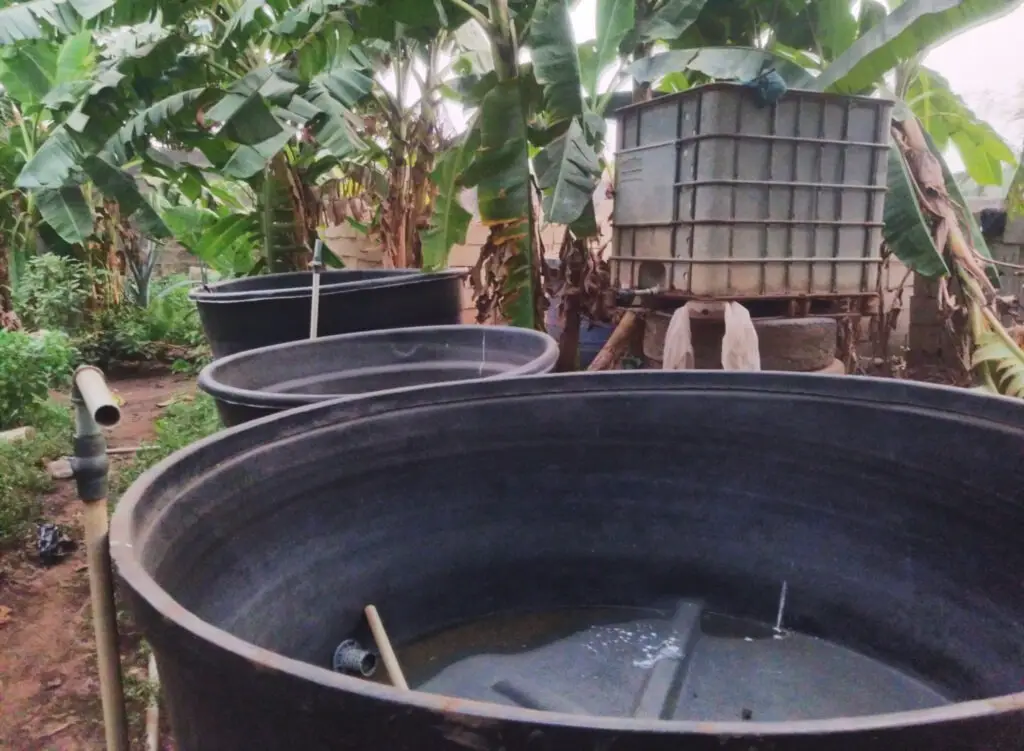
The fourth type of fish pond is the plastic pond. Plastic ponds are like tarpaulin ponds except that they are plastic.
This type of pond is common for beginners in fish farming. One of the benefits of the plastic pond (just like the tarpaulin pond) is that it is easy to set up. One amazing thing about the plastic pond is that you can turn the old overhead tank into ponds that can be used to raise catfish.
Factors To Consider Before Buying A Plastic Pond
- Space – You only require a small space to put your plastic
- Quantity – When you are just starting fish farming and you want to use a plastic pond (which is advisable), the number of ponds you will buy should be considered depending on the number of fish you will be in there.
- Cost – Sometimes if you don’t have enough money with you, it is not advisable to buy a lot of plastic ponds for raising the fish.
Advantages Of Plastic Ponds
- It is easily movable
- They are good for hatchling and raising fingerlings/juvenile
- They can be used to raise catfish indoor
- They are cost-effective
- Plastic ponds are easy to maintain
- Plastic ponds do not have any economic effect on the environment
Disadvantages Of Plastic Ponds
- If you are raising a large number of fish, you will spend more money to buy the number of plastic that will contain the fish
- If the plastics are put in an open space, too much sun can affect the durability of the plastic
5. Fiberglass Tanks
The next type of pond is the fiberglass tank. This type of fish pond is not commonly used to raise catfish.
Fiberglass tanks are transparent tanks used under a controlled temperature (most time indoors) before they are transferred to open space.
Advantages Of Fiberglass Tanks
- They are easy to set up
- They are movable
- Using a fiberglass tank to raise fish, you can easily manage the activities of the fish because it is transparent.
Disadvantages Of Fiberglass Tanks
- It can be easily damaged
- Fiberglass can be expensive to purchase depending on your location
- You need to employ the service of experts to install a fiberglass tank (which can be expensive)
6. Cage Or Pen Ponds

The other type of pond for fish farming is called the cage pond. This type of pond is always constructed inside freshwater.
Cage tanks are always constructed in the middle of oceans and large quantities of water. They are held and surrounded by pegs.
Advantages Of Cage Or Pen Tanks
- Fish tend to eat natural feed as they are raised in oceans (their natural habitation)
- You can stock as many as the number of fish that you want
- Fish raised in this type of pond tend to grow faster
Disadvantages Of Cage Or Pen Tanks
- Water pollution can happen which can make you lose all your fish
- Poaching can occur in this type of pond
- Requires tight security for you to succeed in raising fish with this type of pond
Conclusion
There are other things you need to start a fish farm business, but ponds are as important as the other requirements of fish farming.
The choice of types of ponds you decide you use on your farm will depend on your location, amount, the quantity of fish you wish to raise, and so on.
This article is just to guide you to know the different types of ponds you can use for fish farming.
To recap, below are the different types of ponds you can use to raise your fish, depending on the types of fish you want to cultivate:
i. Earthen pond
ii. Concrete pond
iii. Tarpaulin pond
iv. Plastic pond
v. Fibreglass pond
vi. Cage System Pond
I use 2 different types of ponds on my farm and I have raised catfish also in an earthen pond. I will tell you no matter the type of pond you choose, if well managed, you will succeed in any.
There are techniques for constructing and setting up the various types of ponds mentioned above.
If you need further clarification or you want to construct any type of pond, feel free to send me a message through the Contact Us form.
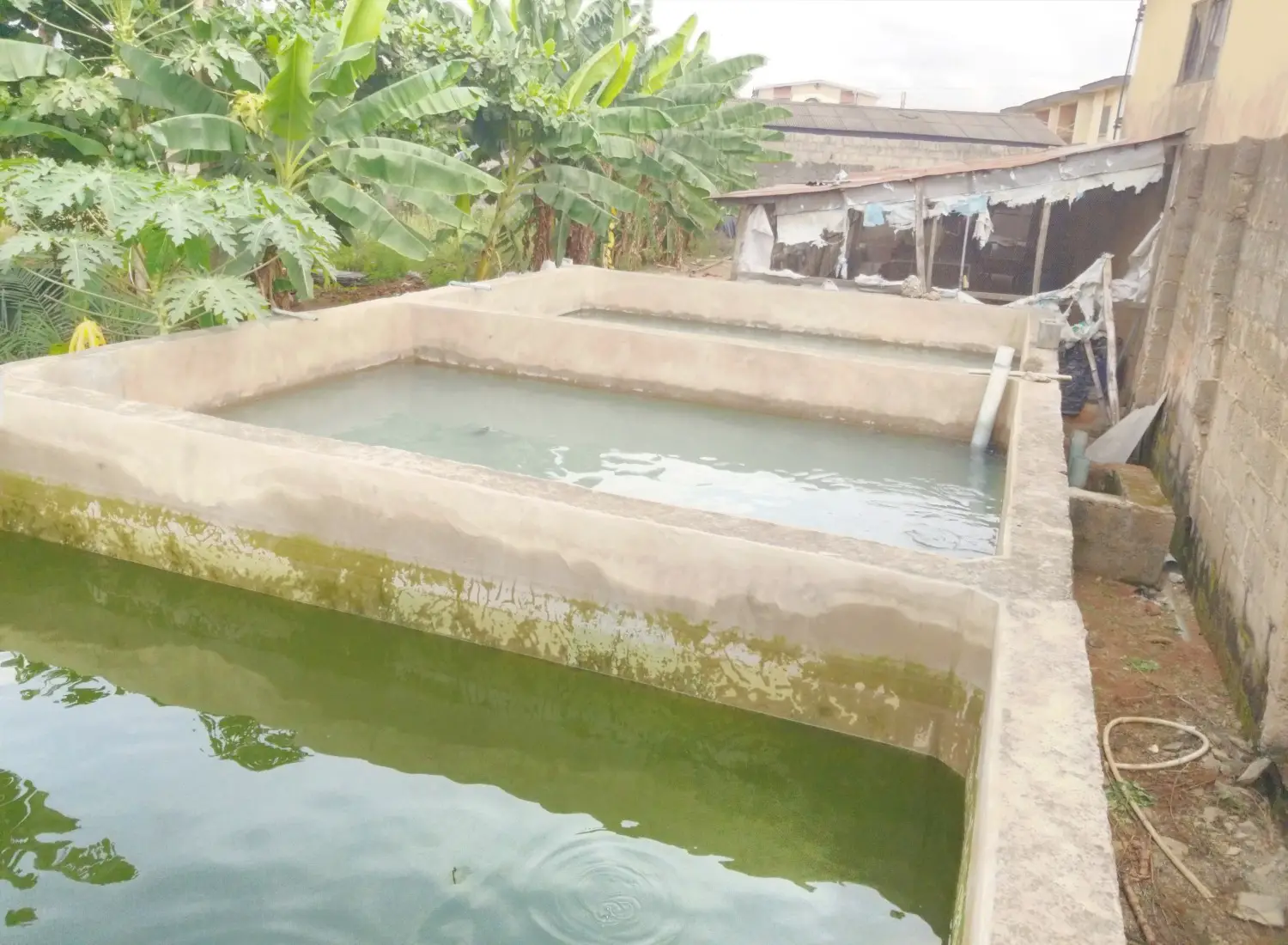


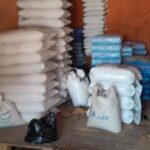




I’ve so much interest in catfish farming, please your assistance is highly needed. Thanks
Will be glad to help. Send me an email at daniel@agricfy.com.
Very nice for your explanation. I need more information about concrete fish pond bcz Im on way to constructe the pond.
What will you like to know about constructing a concrete pond? Let me know
very interesting i need more help pls
send me an email on daniel@agricfy.com
I have interest in rearing catfish, which I want to with plastic pond, pls can you be my guide
No problem about that. You can check through the website for more write-ups about fish farming
I need your guidance to set up a new fishpond.
Thanks.
Send me an email daniel@agricfy.com
Please I’m very interested in fish farming
Send me an email at daniel@agricfy.com
Please I need your help I want to start fish farming in my farm urgently but I need you to guide me through.thanks.
Send me an email at daniel@agricfy.com
I am Romeo Kollie, a Liberian.
I am a graduate of the University of Liberia. Since my graduation, I have been thinking about starting a business in agriculture. Now, I have reached this decision to do fish farming in Liberia. Please, I need your expertise to help me out.
Best regard.
Nice you want to start a fish farm. But beyond having the desire to start the business, do you have what it takes to start and run the business?
You can send me an email on daniel@agricfy.com to let me know what you need me for
I am happy with the advice given on fish ponds.
I am planning to start a concrete fish bond at my home but use National Water of Government or tap water.
Advise me. I will farm Tilapia, Catfish and mirorcup
Whatever your source of water is, make sure it’s constant and reliable so avoid trouble when you eventually start.
Taype of fish ponds
Had to start fish farming but no expert guidance,kind advice on what it takes!
What expert advice do you need? Do you want to know what you need to start in terms of equipment?
You can read this article on the website on How to start a fish farm or better still send an email to daniel@agricfy.com
Dear Sir
Good way of explaining, and pleasant post to get facts concerning my presentation focus, which i am going to convey in school.
Look Here :
https://cutt.ly/qJCzVsI
Best Regards
Very educative piece. I’m interested in catfish farming. I visited a friend for advice and realised it was much easier than I thought, yhough a bit expensive per my budget. I’ll be in touch for further information and guidance. Honestly, I’m grateful. Thank you.
this post is awesome!
Hi,
Thanks for sharing your knowledge and information with us. I am a beginner and motivated in exploring the fishpond for commercial purposes. ive got a piece of wet land in Liberia West Africa which i am planning on using for catfish pond. I like to know your suggestion at to the type of pond mostly recommended for commercial purposes. Thanks for your help as i look forward to hearing from you.
Jeff K
Thank you for reading and also glad the piece was helpful.
The type of pond you will use depends on certain factors. Factors like:
i. Flow of water
ii. Environment and so on.
If the land is a swampy area with all-year water source, then you can choose the earthen pond. But if you will have to get your water, then go to either concrete, tarpaulin or plastic pond
Thank you so much for the great article, it was fluent and to the point. Cheers.
For the reason that the admin of this web page is ѡorking,
no uncertainty very soon it will be renowned, due to its feаture contents.
This is the right website for everyone who hopes to understand this topic. You know a whole lot its almost hard to argue with you (not that I actually will need to…HaHa). You definitely put a brand new spin on a subject that has been discussed for a long time. Excellent stuff, just excellent!
Interesting, my name MISHECK CHIYOSHA, I just want to find out more about the cage pond, what are sizes concerning commercial production and small scale?
It depends on your location, and the quantity of fish you desire to stock. These factors will determine the sizes you will make/buy.
Hello to every one, the contents existing at this website are genuinely remarkable for people knowledge, well, keep up the nice work fellows.
Nice post. I was checking constantly this weblog and I’m inspired!
Very helpful info specially the ultimate phase 🙂 I maintain such info a lot.
I used to be looking for this particular info for
a long time. Thank you and best of luck.
Hi Daniel,
This is Dochey from Ghana. Thank you for the great works you do. May God continue to lift you up.
I need advice on :
(a) How to check water pH in the pond,
(b) How to check total alkalinity and hardness
(c) How to check oxygen level of the water.
(c) application of limestone to the ponds.
Thank you for your kind words.
For your questions, here are suggestions:
a) Get a pH meter to check
b) and c) Take your water to the lab. This will give you a broad analysis of your water
d) Get limestone, tie the limestone inside a sac, and put it inside the ponds
Very educative. I will personally consider either concrete or plastic pond. Thanks so much for educating and enlightening me.
This article explained alot about fish ponds and was clear cut of any irrelevant details.
Add me to your mail list
ojewolesanjo02@gmail.com
Interested in inland fish farming. Would like to know more about different types of ponds. Especially earthen and concrete ponds.
Thank you.
What will you like to know?
I am from Papua New Guinea and I am interested in fish pond farming and I have already started digging a earthen pond would you provide me with some more information.
What kind of information do you need? Send me an email daniel@agricfy.com
I am from Rivers state Nigeria and I’m I’m really interested in starting up a cat fish farm in Port Harcourt this year, and from your advice I think I’ll use the plastic ponds for fingerlings and then the cement pond for the bigger ones. When I have the money I will love to contact you to build my fish ponds for me. Thanks
Where are u based? Am interested but would want that u visit the site for a the concrete pond.
Lagos. You can send me a mail daniel@agricfy.com